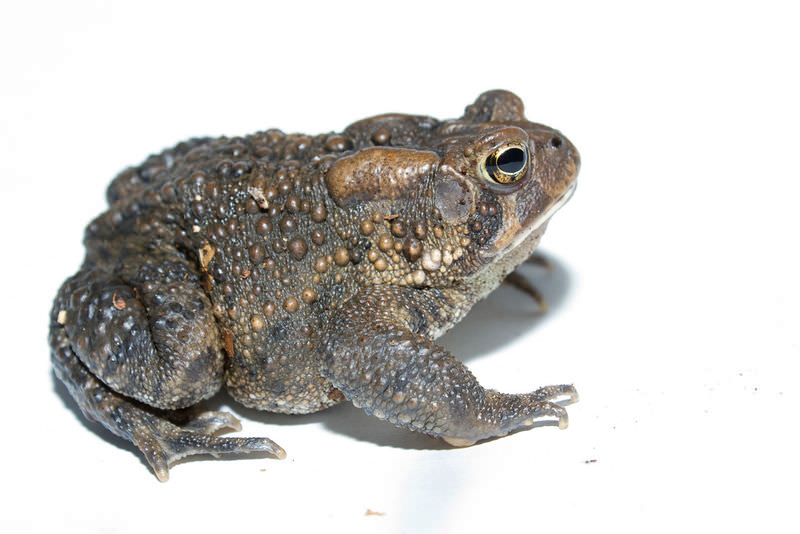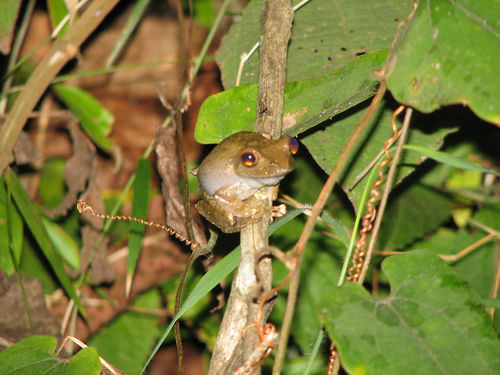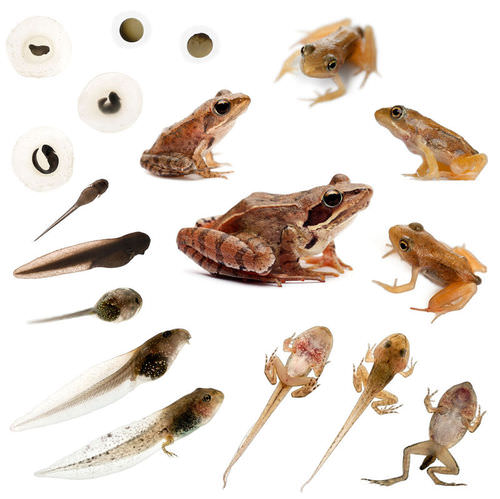10.9: Frogs and Toads
- Page ID
- 14160
\( \newcommand{\vecs}[1]{\overset { \scriptstyle \rightharpoonup} {\mathbf{#1}} } \)
\( \newcommand{\vecd}[1]{\overset{-\!-\!\rightharpoonup}{\vphantom{a}\smash {#1}}} \)
\( \newcommand{\id}{\mathrm{id}}\) \( \newcommand{\Span}{\mathrm{span}}\)
( \newcommand{\kernel}{\mathrm{null}\,}\) \( \newcommand{\range}{\mathrm{range}\,}\)
\( \newcommand{\RealPart}{\mathrm{Re}}\) \( \newcommand{\ImaginaryPart}{\mathrm{Im}}\)
\( \newcommand{\Argument}{\mathrm{Arg}}\) \( \newcommand{\norm}[1]{\| #1 \|}\)
\( \newcommand{\inner}[2]{\langle #1, #2 \rangle}\)
\( \newcommand{\Span}{\mathrm{span}}\)
\( \newcommand{\id}{\mathrm{id}}\)
\( \newcommand{\Span}{\mathrm{span}}\)
\( \newcommand{\kernel}{\mathrm{null}\,}\)
\( \newcommand{\range}{\mathrm{range}\,}\)
\( \newcommand{\RealPart}{\mathrm{Re}}\)
\( \newcommand{\ImaginaryPart}{\mathrm{Im}}\)
\( \newcommand{\Argument}{\mathrm{Arg}}\)
\( \newcommand{\norm}[1]{\| #1 \|}\)
\( \newcommand{\inner}[2]{\langle #1, #2 \rangle}\)
\( \newcommand{\Span}{\mathrm{span}}\) \( \newcommand{\AA}{\unicode[.8,0]{x212B}}\)
\( \newcommand{\vectorA}[1]{\vec{#1}} % arrow\)
\( \newcommand{\vectorAt}[1]{\vec{\text{#1}}} % arrow\)
\( \newcommand{\vectorB}[1]{\overset { \scriptstyle \rightharpoonup} {\mathbf{#1}} } \)
\( \newcommand{\vectorC}[1]{\textbf{#1}} \)
\( \newcommand{\vectorD}[1]{\overrightarrow{#1}} \)
\( \newcommand{\vectorDt}[1]{\overrightarrow{\text{#1}}} \)
\( \newcommand{\vectE}[1]{\overset{-\!-\!\rightharpoonup}{\vphantom{a}\smash{\mathbf {#1}}}} \)
\( \newcommand{\vecs}[1]{\overset { \scriptstyle \rightharpoonup} {\mathbf{#1}} } \)
\( \newcommand{\vecd}[1]{\overset{-\!-\!\rightharpoonup}{\vphantom{a}\smash {#1}}} \)
\(\newcommand{\avec}{\mathbf a}\) \(\newcommand{\bvec}{\mathbf b}\) \(\newcommand{\cvec}{\mathbf c}\) \(\newcommand{\dvec}{\mathbf d}\) \(\newcommand{\dtil}{\widetilde{\mathbf d}}\) \(\newcommand{\evec}{\mathbf e}\) \(\newcommand{\fvec}{\mathbf f}\) \(\newcommand{\nvec}{\mathbf n}\) \(\newcommand{\pvec}{\mathbf p}\) \(\newcommand{\qvec}{\mathbf q}\) \(\newcommand{\svec}{\mathbf s}\) \(\newcommand{\tvec}{\mathbf t}\) \(\newcommand{\uvec}{\mathbf u}\) \(\newcommand{\vvec}{\mathbf v}\) \(\newcommand{\wvec}{\mathbf w}\) \(\newcommand{\xvec}{\mathbf x}\) \(\newcommand{\yvec}{\mathbf y}\) \(\newcommand{\zvec}{\mathbf z}\) \(\newcommand{\rvec}{\mathbf r}\) \(\newcommand{\mvec}{\mathbf m}\) \(\newcommand{\zerovec}{\mathbf 0}\) \(\newcommand{\onevec}{\mathbf 1}\) \(\newcommand{\real}{\mathbb R}\) \(\newcommand{\twovec}[2]{\left[\begin{array}{r}#1 \\ #2 \end{array}\right]}\) \(\newcommand{\ctwovec}[2]{\left[\begin{array}{c}#1 \\ #2 \end{array}\right]}\) \(\newcommand{\threevec}[3]{\left[\begin{array}{r}#1 \\ #2 \\ #3 \end{array}\right]}\) \(\newcommand{\cthreevec}[3]{\left[\begin{array}{c}#1 \\ #2 \\ #3 \end{array}\right]}\) \(\newcommand{\fourvec}[4]{\left[\begin{array}{r}#1 \\ #2 \\ #3 \\ #4 \end{array}\right]}\) \(\newcommand{\cfourvec}[4]{\left[\begin{array}{c}#1 \\ #2 \\ #3 \\ #4 \end{array}\right]}\) \(\newcommand{\fivevec}[5]{\left[\begin{array}{r}#1 \\ #2 \\ #3 \\ #4 \\ #5 \\ \end{array}\right]}\) \(\newcommand{\cfivevec}[5]{\left[\begin{array}{c}#1 \\ #2 \\ #3 \\ #4 \\ #5 \\ \end{array}\right]}\) \(\newcommand{\mattwo}[4]{\left[\begin{array}{rr}#1 \amp #2 \\ #3 \amp #4 \\ \end{array}\right]}\) \(\newcommand{\laspan}[1]{\text{Span}\{#1\}}\) \(\newcommand{\bcal}{\cal B}\) \(\newcommand{\ccal}{\cal C}\) \(\newcommand{\scal}{\cal S}\) \(\newcommand{\wcal}{\cal W}\) \(\newcommand{\ecal}{\cal E}\) \(\newcommand{\coords}[2]{\left\{#1\right\}_{#2}}\) \(\newcommand{\gray}[1]{\color{gray}{#1}}\) \(\newcommand{\lgray}[1]{\color{lightgray}{#1}}\) \(\newcommand{\rank}{\operatorname{rank}}\) \(\newcommand{\row}{\text{Row}}\) \(\newcommand{\col}{\text{Col}}\) \(\renewcommand{\row}{\text{Row}}\) \(\newcommand{\nul}{\text{Nul}}\) \(\newcommand{\var}{\text{Var}}\) \(\newcommand{\corr}{\text{corr}}\) \(\newcommand{\len}[1]{\left|#1\right|}\) \(\newcommand{\bbar}{\overline{\bvec}}\) \(\newcommand{\bhat}{\widehat{\bvec}}\) \(\newcommand{\bperp}{\bvec^\perp}\) \(\newcommand{\xhat}{\widehat{\xvec}}\) \(\newcommand{\vhat}{\widehat{\vvec}}\) \(\newcommand{\uhat}{\widehat{\uvec}}\) \(\newcommand{\what}{\widehat{\wvec}}\) \(\newcommand{\Sighat}{\widehat{\Sigma}}\) \(\newcommand{\lt}{<}\) \(\newcommand{\gt}{>}\) \(\newcommand{\amp}{&}\) \(\definecolor{fillinmathshade}{gray}{0.9}\)
Frog or toad?
Although there is actually little difference between toads and frogs, this animal would most often be called a toad. Frogs have moist skin, while toads have dry, bumpy skin.
Frogs and Toads
Frogs and toads are amphibians in the order Anura. In terms of classification, there is actually not a big difference between frogs and toads. Frogs often have long legs that are good for hopping, skin that is smooth and moist, and special pads on their toes that help them climb. Toads are more heavyset with shorter legs, and usually have drier skin, often with warty-looking bumps. Frogs are more likely to live in or near water than toads.
Frogs are found in many areas of the world, from the tropics to subarctic regions, but most species are found in tropical rainforests. Consisting of more than 5,000 species (about 88% of amphibian species are frogs), they are among the most diverse groups of vertebrates. Frogs range in size from less than 0.5 inches in species in Brazil and Cuba to the over 1-foot (33 cm) long goliath frog of Cameroon, which can weigh up to 7 pounds. That is 1-foot from the nose to the back of the body, not including the length of the legs. Even the largest frogs are significantly smaller than common reptiles.
Characteristics of Frogs
Adult frogs are characterized by long hind legs, a short body, webbed finger-like parts, and the lack of a tail. They also have a three-chambered heart, as do all tetrapods except birds and mammals. Most frogs live part of the time in water and part of the time on land. They move easily on land by jumping or climbing. To become great jumpers, frogs evolved long hind legs and long ankle bones. They also have a short backbone with only ten vertebrae. Frog and toad skin hangs loosely on the body, and skin texture can be smooth, warty, or folded.
Frogs and toads don’t have fur, feathers, or scales on their skin. Instead, they have a moist and permeable skin layer covered with mucous glands. Their special skin allows them to breathe through their skin in addition to using their lungs. They are vulnerable to water loss through the skin in dry conditions, which is why they need to live near water or in moist environments. The thin layer of mucous keeps the skin moist.
In order to live on land and in water, frogs have three eyelid membranes: one is see-through to protect the eyes underwater, and the two other ones let them see on land. Frogs also have a tympanum, which acts like a simple ear. They are found on each side of the head. In some species, the tympanum is covered by skin.

How do Frogs Reproduce?
Frogs typically lay their eggs in puddles, ponds, or lakes. Their larvae, or tadpoles, have gills, a tail, but no legs, and need to live in water. If fact, they are quite similar to a fish. Tadpoles develop into adult frogs in water (Figure below). During this transformation, they develop lungs, lose their tails and form their four legs.
You may hear males "ribbiting," producing a mating call used to attract females to the bodies of water best for mating and breeding. Frog calls can occur during the day or night. Each frog species has a different call that is used to attract mates and warn off rivals. When a female picks a male whose call she likes, the male grabs her and squeezes across her back and around her abdomen. This causes the female to release her eggs. The male then fertilizes the eggs and, in some species, also guards them.

How Do Frogs Eat?
Adult frogs are meat-eaters and eat mostly insects, spiders, slugs and worms. Larger species will eat mice, birds, and even other small reptiles and amphibians. Frogs do not have teeth on their lower jaw, so they usually swallow their food whole. Some frogs have teeth on the upper jaw that are used to hold the prey in place.
Frogs and toads are responsible for keeping a large part of the world's insect population under control. They catch these insects using their long tongue. The frog tongue is about a third the length of the frog's body, though they can grow even longer. They can easily reach 12 inches long in an adult frog. Frog’s tongues are attached to the front of their mouths rather than at the back like humans. They release a sticky substance at the precise moment of impact with their food. When a frog catches an insect it throws its sticky tongue out of it’s mouth and wraps it around its prey. The frog’s tongue then snaps back and throws the food down its throat. This happens about as fast as a blink of your eyes.
Summary
- Frogs are characterized by long hind legs, webbed finger-like parts, a tympanum, and the lack of a tail.
- A frog's "ribbit" is a mating call used to attract females.
Explore More
Use the video below to answer the questions that follow.
- Where do Rain Frogs spend most of their time?
- How does the Rain Frog mate?
- Why is "glue" used in Rain Frog mating? What problems can this cause?
- Why do Rain Frogs make their nurseries?
- How is the Rain Frog's behavior adaptive to its environment.
Review
- Distinguish between frogs and toads.
- What are three characteristics of frogs?
- What allowed frogs to become effective jumpers?
- Why do frogs "ribbit"?
- Describe the frog tadpole and the changes it undergoes.

